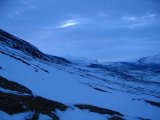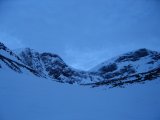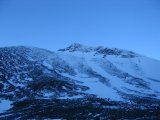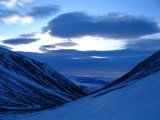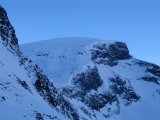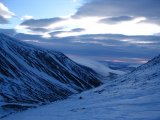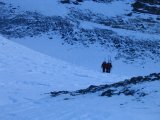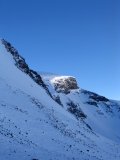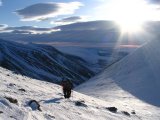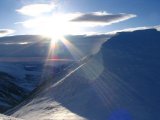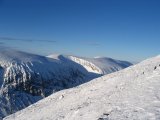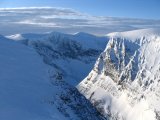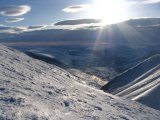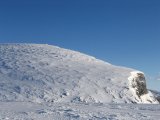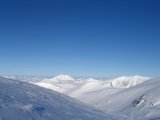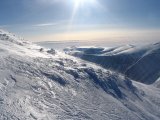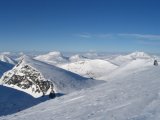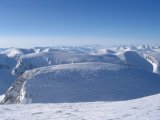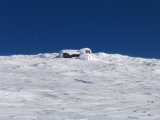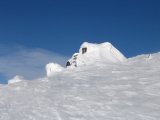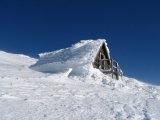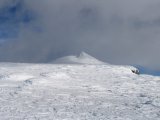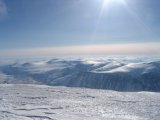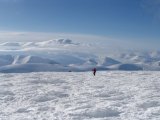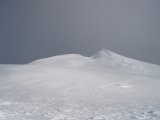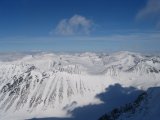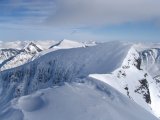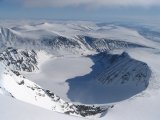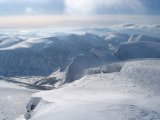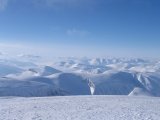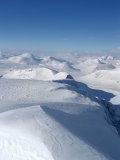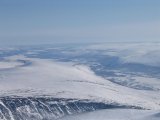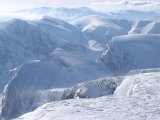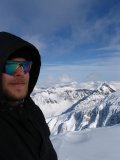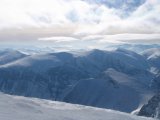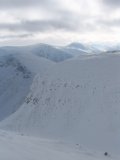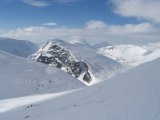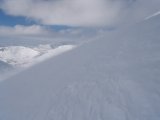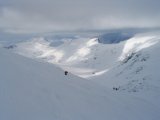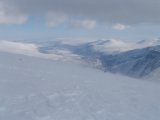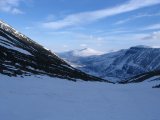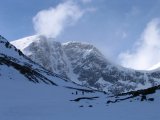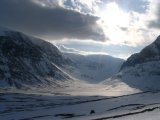Sunday 25/3
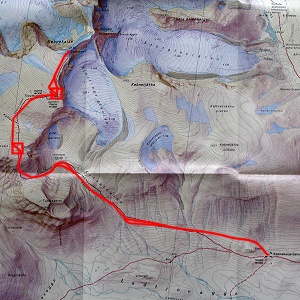
South Peak
| Horizontal distance: | 18 km |
| Vertical distance: | +1000 m, -200 m, +600 m, -600 m, +200 m, -1000 m |
| Time: | 11 h 15 min |
| Food breaks: | 30 min, 45 min |
| Dinner: | – |
| Night accommodation: | – |
| Stage classification: | Medium/Hard |
| Map points: | Old top cabin, South Peak |
Just before 04:00 (CEST), Anna A, Nina, Johanna L and I arose with what at least I found to be moderate ease. The darkness of night still had its hold on the world, the stars were all alight, and a few shreds of cloud moved with the light wind as we made our way to the main building to have breakfast. My throat ache persisted, but after a warm cup of tea it faded, and I felt perfectly fine otherwise, so it was a go. We put the last touches on our respective packs and departed a few minutes before 5.
While it was still dark, a dim light had started to grow in the east, and it was enough to proceed safely with unaided eyes. The others had put on their climbing skins from the start, but I decided to wait until we reached the entrance to Kitteldalen where the actual ascent was to start, hoping to take advantage of the inherent gliding properties of the skis on the way there. Since the snow was rather hard and slippery from the recent winds and cold, this had the effect that I got to work much more from the start when we were rounding Kaipak on the north side, but once that was over I had an easy time. In fact, I ended up leading the party with several hundred meters at the longest, acting as pathfinder between the numerous bare patches of varying size.
At Giebmejohka there was a longer pause since one of Nina's skins had come loose at the tip, which required fixing, and I put on my own skins as well. We then proceeded up Kitteldalen in the ravine of the frozen stream, which was largely uncomplicated; there was certainly no shortage of snow, and it was nice and even in most places, bearing a multitude of tracks of various kinds. The westerly wind, which had been light but constant all the way through Láddjuvággi, was now increasing, and high clouds rolling in from the west were forming a blanket overhead. Up in the bowl itself the gusts were strong enough to cause snow devils, but the clouds were breaking up again – dense banks were still present in the southeast and east, but they were moving off too.
We resolved to continue on skis up into the saddle between Duolbagorni and Vierranvárri, and reevaluate there. While relatively easy at first, the steep slant in combination with the tough snow soon increased the difficulty level several notches. My companions elected to take off their skis, fix them on the rucksacks and walk up, but stubborn as I am I persevered. Without incident I eventually found myself on mostly level ground, and I waited for the others there in stronger wind still. As the adjacent slope of Vierranvárri showed all signs of being at least as troublesome, with hard, icy snow in most uneven distributions and quite a bit of bare rock, we quickly reached a consensus to leave the skis in the saddle.
While we were preparing to continue on foot, the sun finally made its first appearance of the day, painting the visible parts of Giebmegáisi with a welcoming light. Whether an omen or not, this did not exactly discourage us. There were still several sets of tracks visible, so we followed those up Vierranvárri. In many places there was little enough snow that the red-painted stones which mark the western trail in the summer were visible, and as it turned out we were following that route quite well, without really trying. The snow itself was hard in general, but its crust had the irritating habit of breaking at fairly regular intervals, which when combined with the hard wind made progress taxing, albeit not overly difficult per se.
Again I ended up in the vanguard, reaching the crest several minutes before the rest of the party, and I used this time to go to the actual top of the mountain a little bit further west to scan for signs of weather changes – at 1711 m, one can see pretty much to the Atlantic from there. I saw nothing of a threatening nature; in fact, everything seemed almost unnaturally clear and promising. There was, of course, the roaring wind, but visibility was perfect and drifting snow was at a minimum thanks to the hard crust. We regrouped at 08:45, finding the elapsed time well on schedule – the top of Vierranvárri is the crucial point of no return, where one should take several moments to evaluate one's progress and prospects, which may or may not lead to a more or less difficult decision to turn back. We sat down behind a large stone to get some protection against the wind and had a forenoon snack before finally deciding what to do.
With weather conditions as favorable as they were, and our physical form as good as it apparently was, there was no question about it: we were going to the top. As we were descending into Kaffedalen the sky was entirely clear except for a patch far to the southeast, and the crust which during the first portion of the descent kept breaking soon stabilized, making the rest of the walk down rather an easy affair. Down in the valley there was no wind and the sun was warming; we joked about setting up camp there instead since it was so nice.
But no, we then started the ascent of Giebmegáisi proper, again following old tracks – and the red trail markings – on and off. This was not a difficult part of the journey, and I soon caught sight of the New top cabin. That building is, however, in such a poor condition nowadays, whereas its Old top cabin counterpart has been renovated, so we aimed for the latter a few hundred meters further east. Since I arrived early I set about shovelling away heaps of snow which had accumulated around – and in – the entrance while I waited for the rest to catch up. We left our rucksacks inside, and after a brief pause we set out on the final stage.
That was when something a bit worrying came about: small chunks of cloud had started to race – and I do mean race – past, apparently being served by a larger bank that had somehow formed around the Norwegian border. They were much too small and intermittent to raise security concerns, of course, but they significantly lowered the probability of having a clear view from the summit, which was a bit of a downer. Still, I figured that with the speed they were moving, it would merely be a matter of waiting up there for a while in order to see what we wanted, and we proceeded with high spirits.
We went up rather close to the sharp precipice making up the eastern wall of the massif at first, then turned northwest, and finally aimed directly for the South Peak, which was coming into view. As expected, the rushing clouds were passing just above it, but not really touching it, and the wind on the top plateau leading up to the summit glacier was the hardest yet. This time I was accompanied by Nina at the front, and since she was the only one in our party that had not been up before I ushered her before me the final steps...
...and just as we took those steps, at 11:30, the clouds dissipated and the wind ceased! A curious phenomenon indeed, but the fact was that on the highest peak of Sweden right then, it was clear and calm. Truly incredible, and a nice contrast to my last visit. Anna and Johanna soon joined us, and we spent some time taking photographs in all directions and calling to taunt the receptionist who had made a failed attempt a few days before. All in all, it was immensely satisfying in every respect.
When we at length felt that we had had enough, we went down in a south-southwestward direction. Back down on the summit plateau the wind jumped back with a vengeance, and we had no more started to go down the slope to the cabin than the drifting clouds returned as well. Talk about timing! Our route this time took us further west than expected, which was quickly discovered when the roof of the New top cabin emerged, so we made a sharp eastward turn. Back at the correct building we found a whole platoon of conscripts, who had their tent camp down on Storglaciären and were now having lunch on their way to the top. They were all sitting outside, so we went inside ourselves to have our own lunch and to exchange some items of clothing.
We were all getting ready to leave at about the same time, but when we reemerged into the open air we saw that the clouds had gotten both lower and denser rather than lifting again, and the wind was now at summit-plateau-strength. The route back down, over Vierranvárri, was still well in the clear, but the ceiling hung not far above our present location, so the military men can't have seen much at all, if they even made it all the way up. Again, timing is everything.
We civilians made our way down into Kaffedalen in a slightly more straightforward manner compared to the way up, and down in the valley we took a general break. The second ascent of Vierranvárri was also tiring, with frequent collapses of the crust and much wind. Right at the top both visibility and wind strength were at their worst; we were very close to hitting the ceiling then, but we only needed to pass the crest for the view to clear again. We then spotted a trio slowly making their way down to the saddle ahead of us, and since there had been no one but the soldiers up there with us these people must have aborted their attempt – or perhaps Vierranvárri had been their goal. In either case we soon overtook them further west, and they chose to follow in our footprints. And speaking of footprints – after a while we had to go east for a bit since the terrain was getting too difficult on our present course, and we then came upon our own tracks from the morning, which we then traced all the way back to our skis.
My companions were going to walk down into Kitteldalen as well, but I wanted to at least attempt to go down on skis, so I set about taking off the skins while they made a head start. The strong tailwind and the icy snow complicated things for me, but I managed to reach the bottom of the slope without injury, but with a good deal of exhilaration. For me the remaining way down through Giebmejohka's ravine into Láddjuvággi was as "comfortable" as I had expected, but the others felt less secure when it came to downhill turns on cross-country equipment, so they elected to slide down on their respective behinds. The wind was changing back and forth, but it was fairly light in average, and when we exited Kitteldalen the snow turned mushy. Yet again I went on ahead, but I waited behind Kaipak so that we could make a joint return just after 16:15, which put our time well below the classic 12-hour mark for a summit expedition.
« Return to Kebnekaise report
